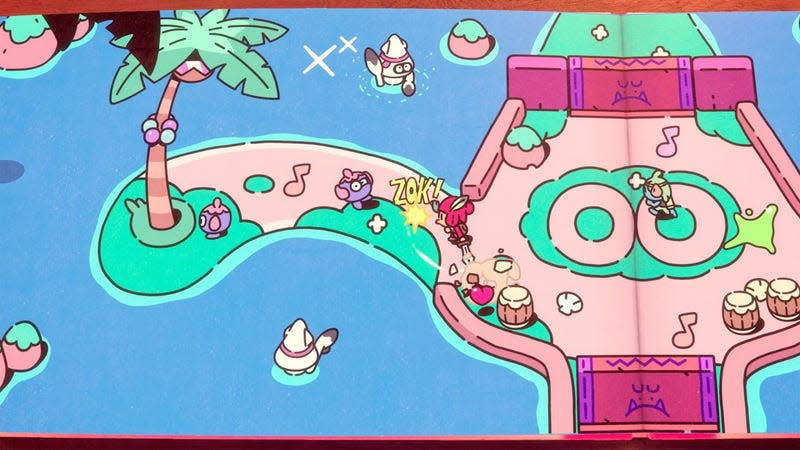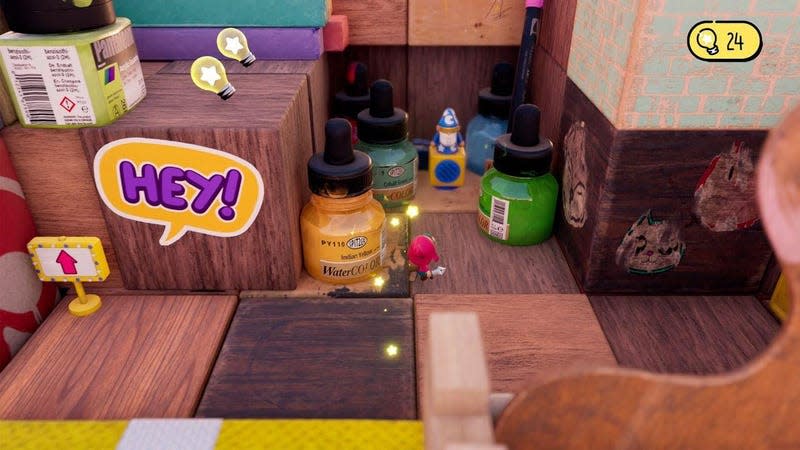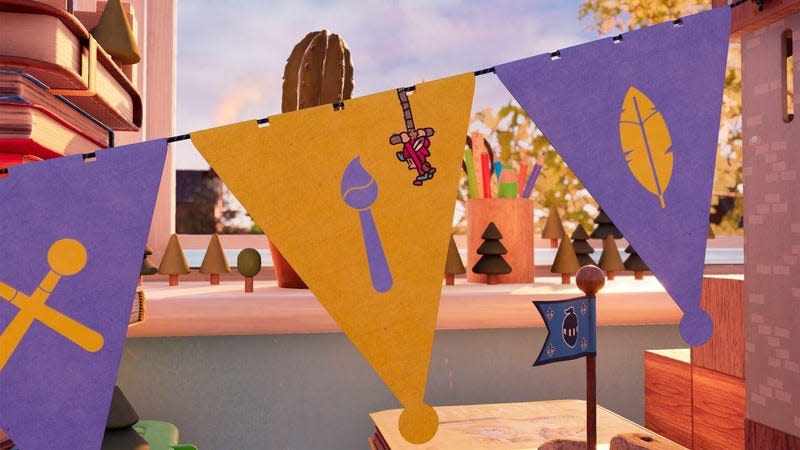This Nostalgic Zelda-Like Is A Delightful Love Letter To Gaming
Do you remember the first game you fell in love with? For me it was The Legend of Zelda: Ocarina of Time. Some of my earliest memories are of sitting in front of a small CRT TV set up in the living room watching my brother run through the fields of Hyrule. Before even getting the controller in my own hands, Ocarina of Time began what would become a life-long love of the medium.
That love of video games is proudly on display in The Plucky Squire, an adorable platformer that blends 2D and 3D influences from throughout the medium’s history. Developer All Possible Futures pulls off a wonderful feat in this short homage to the games that helped define a generation, which works not only as a potent piece of nostalgia but also as a delightful experience in its own right. While a little rough around the edges in some places, The Plucky Squire is a game so full of heart that it’ll remind you every step of the way why games are so special.
See The Plucky Squire on Humble Bundle - G/O Media may get a commission
Leaping off the page
The developers at All Possible Futures are, like me and millions of other gamers, clearly fans of classic Zelda games. The Plucky Squire is, at its simplest, a Zelda-like inspired by the golden age of the NES and SNES—think titles like the original 1986 Zelda or 1991’s A Link to the Past. In a top-down 2D perspective, you control Jot—the titular Squire full of pluck—as he fights bad guys and solves puzzles.

The narrative wrinkle of The Plucky Squire is that Jot and all the other people you encounter are characters within a children’s story book titled, you guessed it, The Plucky Squire. To emphasize this the game turns the screen-to-screen transitions of early Zelda titles into a page turning in the book, revealing the next part of the map. It’s little flourishes like this that help emphasize the charm of The Plucky Squire. The game’s roughly ten-hour adventure begins when the evil Humgrump becomes aware of his literary prison and finds a way to kick Jot out of the book and begins a campaign to change the story for his own benefit.
Once Jot is jettisoned out of his story, you find yourself on the desk of a young kid named Sam who loves The Plucky Squire. The game then transitions from a 2D Zelda-like to a 3D platformer, taking inspiration from yet another era of gaming. Here you do more fighting, puzzling, and jumping in an attempt to return to Jot’s home, which you quickly accomplish. From this point forward, The Plucky Squire becomes a multi-dimensional puzzle that tasks you with jumping in and out of the storybook to complete the roadblocks Humgrump puts in your way.

Jot is able to do this with the aid of a growing list of tools that let him meddle with the metatextual nature of his adventure. This leads to some truly delightful levels, such as one that required me to freeze an object on the page and then close the book to transfer that object to the opposite page to then unlock a door. Combat does exist in the game, and it’s serviceable enough, but the multi-faceted puzzles are where The Plucky Squire shines.
A link to the past
The Plucky Squire doesn’t just honor classic 2D and 3D games in its core gameplay—you’ll be faced with a number of minigames clearly cribbing from iconic games of the past throughout your adventure. An early boss fight turns into a boxing match straight out of Punch-Out!! complete with dodging, jabbing, and uppercuts. A more stealth-based section late in the game seems to pull from a much more recent title, requiring you to navigate a short dungeon while moving to the beat a la 2015’s Crypt of the NecroDancer. I won’t spoil every send-up for you but know that the list is long, and each one is clearly made with love.
While each of these homages look incredible, rendered in adorable 2D illustrations or 3D models, they all feel a little off. I mean this quite literally, the controls of each minigame—and to some extent the game at large—are consistently somewhat unresponsive. I first noticed this in an early 2D platforming level that takes on the side-scrolling perspective of a Mario game, when prompting Jot to jump never behaved quite as expected. —I’d always fall a little short due to the unexpected sluggishness of his movement. A similar problem occurred in a rhythm-inspired minigame where the proper input window felt completely unsynced to the beat. These imperfections are made less frustrating thanks to a wonderful array of accessibility options that go as far as to let you skip a minigame that is giving you too much trouble. I do, however, wish that the controls themselves were a little tighter across the board.
It’s almost surprising to see so much gaming history in The Plucky Squire’s DNA considering how angled towards kids the game feels. It’s perfect for a parent to give to their child in the hopes of fostering a love for games in the next generation, even if that generation may have little to no knowledge of The Plucky Squire’s references. A kid is still likely to have a good time thanks to how delightful the puzzle-solving is, while a parent watching over their shoulder can smile knowingly at every homage. The story itself is simple, sweet, and easy to understand. This does mean that the more adult gamer might get a bit bored at times, but there are some jokes and clever tidbits throughout to help keep you interested. Though within all of that is a message about the importance of art at a young age and the power it has to inspire. The Plucky Squire is for kids, and that’s its greatest strength.
Forward thinking

The result of classic games successfully enrapturing an entire generation led to something wonderful: more video games. There would not be a modern gaming industry without the kids who fell in love with Zelda on the Famicom in 1986. They would become lifelong players, critics, and developers. They would be the ones who made the games that the next generation would fall in love with, who in turn would become inspired to make even more games.
The Plucky Squire is all about that lineage of art, inspiration, and creation. The most important role Jot fills as the hero of his book isn’t that of Humgrump’s vanquisher, rather it is his ability to inspire the kid whose desk his book sits on to create something of their own. Every person has a story about what game made them fall in love with the medium, and there is a chance that The Plucky Squire becomes that for some kid that plays it—the thing that will push them to create. How can you not be romantic about video games?
See The Plucky Squire on Humble Bundle - G/O Media may get a commission
.
